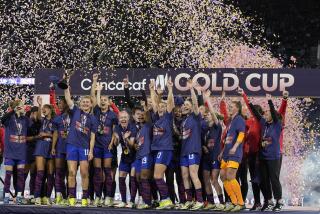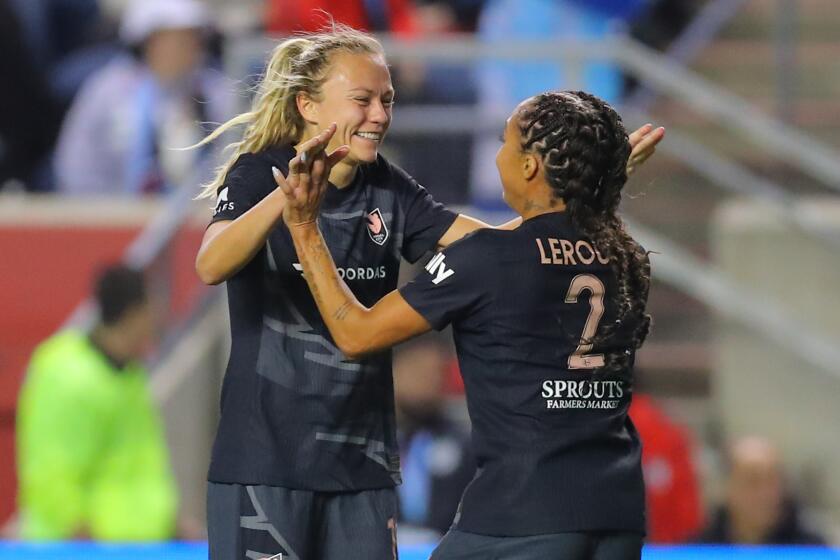Women’s soccer in Mexico growing with help from U.S. players
There was a time when Veronica Perez’s soccer career, like her citizenship status, was split between two countries.
Born in the U.S. to Mexican parents, Perez could play for either side. So in 2009, she did.
After her first start with the U.S. under-23 national team, the Americans’ interest quickly waned. Mexico, on the other hand, asked if she’d like to play on its World Cup team.
“I was like, ‘Of course.’ Why would I give up that opportunity?” Perez said.
But if the choice were easy, it was also emotional: The first time Perez played a competitive game against the U.S., she had to bite the insides of her cheeks to keep from singing “The Star-Spangled Banner.”
Twenty-seven minutes later, she scored the deciding goal in a 2-1 Mexican victory, and she never looked back.
“Now that I’ve been on the team for five years, I’m really comfortable playing for Mexico and representing Mexico,” said Perez, who will do that again Sunday when Mexico and the U.S. meet at StubHub Center (Fox Sports 1, 6 p.m.) in a warmup game for this summer’s Women’s World Cup.
Twelve players on Mexico’s preliminary 24-woman World Cup roster were either born in the U.S. or grew up there, with nine coming from California. For each, playing for Mexico wasn’t about turning their backs on one country. It was about embracing an opportunity from another.
“To play for a country where my family is from is such an honor,” said Bianca Sierra, a 22-year-old defender from Livermore who played briefly in the Olympic Development Program in the U.S. before joining Mexico’s U-20 team in 2009. “Seeing the way my grandparents’ faces light up every time they ask me about how camp went or how the team is doing is really special.
“When I was given the opportunity at such a young age, I jumped right on it. I didn’t think twice.”
Mexico isn’t the only national federation to recruit dual nationals, whose birthplace or heritage make them eligible to play for more than one country. U.S. forward Sydney Leroux played in an age-group World Cup for Canada before jumping to the American U-20 team. And in last summer’s men’s World Cup, the U.S. roster included five Germans, a Norwegian and a former Icelandic international.
“It’s kind of a neat thing,” said Tony DiCicco, who coached the U.S. to its last Women’s World Cup title in 1999. “When a country sees that there’s a possibility of dual citizenship and the player’s American, they’re probably going to take a look. So we have [U.S.] players playing in the Caribbean and Europe.
“I think that’s great.”
But while Americans will dot the rosters of more than half a dozen teams in this summer’s World Cup, few pursue American players as doggedly as Mexico. When Leonardo Cuellar, who played for San Jose and San Diego in the North American Soccer League, became coach of Mexico’s women’s national team in 1998, he immediately recognized that the youth and college programs in the U.S. were light-years ahead of anything available to women in Mexico.
In fact, when Maribel Dominguez, Mexico’s career leader in international games and goals, was growing up on the edges of Mexico City, there were no girls’ teams for her to play with. She cut her hair short and pretended to be a boy — her brothers called her Mario — so she could play on all-male teams instead.
“Everybody knows, even casual fans, that women’s soccer does not get the same support from the Mexican federation like the boys,” said Carlos Rodriguez, a sportswriter based in Mexico City. “I think we all know how hard it is for them to compete at the highest level.”
Dominguez softened that machismo by leading her team to two World Cups while becoming the only player in Mexican history to score in a Women’s World Cup, the Olympic Games, the Pan American Games and the CONCACAF championships. And that made it easier for other women in Mexico such as Paola Espinosa, a two-time Olympic medalist in diving, and Maria Espinoza, an Olympic and world champion in taekwondo, to pursue their sports.
An injury will keep Dominguez, 36, out of this summer’s World Cup, but it hasn’t stopped her from trying to break other barriers: She’s a candidate for a seat in the lower house of the Mexican Congress in elections scheduled for June 7, the day after the World Cup kicks off.
Meanwhile, her former teammates try to build on her legacy, staging clinics and other events for girls in Mexico — the same kinds of girls who once had to cut their hair and answer to a boy’s name if they wanted to play. And as those programs grow, so does the chance that Mexico will one day field a Women’s World Cup team whose first language is Spanish, not English.
“The women’s game is growing a ton in Mexico City,” Sierra said. “I really feel like we are role models for young girls. I just try to be the best that I can be every day so that young girls can continue to look up to me and follow their dreams.”
Twitter: @kbaxter11
California girls
12 players on Mexico’s preliminary Women’s World Cup roster are from the U.S.: nine from California, two from Arizona and one from Texas:
Renae Cuellar (La Puente)
Alina Garciamendez (Los Gatos)
Christina Murillo (Ojai)
Teresa Noyola (born in Mexico City, raised in Palo Alto)
Amanda Perez (San Mateo)
Veronica Perez (San Mateo)
Jennifer Ruiz (Anaheim)
Tanya Samarzich (Upland)
Bianca Sierra (Livermore)
Greta Espinoza (born in Tijuana, went to school in Arizona)
Arianna Romero (Glendale, Ariz.)
Monica Alvarado (Southlake, Texas)







